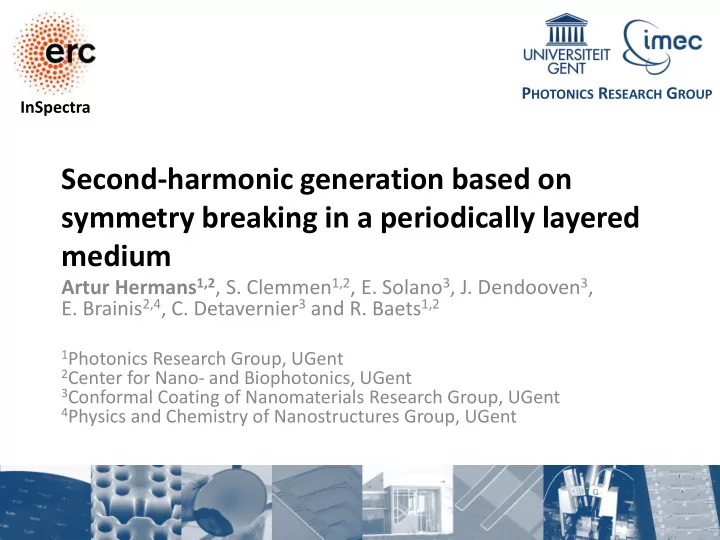

P HOTONICS R ESEARCH G ROUP InSpectra Second-harmonic generation based on symmetry breaking in a periodically layered medium Artur Hermans 1,2 , S. Clemmen 1,2 , E. Solano 3 , J. Dendooven 3 , E. Brainis 2,4 , C. Detavernier 3 and R. Baets 1,2 1 Photonics Research Group, UGent 2 Center for Nano- and Biophotonics, UGent 3 Conformal Coating of Nanomaterials Research Group, UGent 4 Physics and Chemistry of Nanostructures Group, UGent P HOTONICS R ESEARCH G ROUP 1
Second order nonlinear optical effects In linear optics: 𝐐 = ε 0 χ 1 𝐅 In nonlinear optics: 𝐐 = ε 0 χ 1 𝐅 + ε 0 χ 2 𝐅𝐅 + ε 0 χ 3 𝐅𝐅𝐅 + ⋯ P HOTONICS R ESEARCH G ROUP 2
Second order nonlinear optical effects In linear optics: 𝐐 = ε 0 χ 1 𝐅 In nonlinear optics: 𝐐 = ε 0 χ 1 𝐅 + ε 0 χ 2 𝐅𝐅 + ε 0 χ 3 𝐅𝐅𝐅 + ⋯ Second-harmonic generation (SHG), sum frequency generation (SFG), difference frequency generation (DFG), Pockels effect, ... SHG SFG DFG P HOTONICS R ESEARCH G ROUP 3
Why do we need 2nd order nonlinear effects? • Wavelength conversion E.g. optical parametric amplifiers/oscillators, frequency doubling in green laser pointers http://www.coherent.com/products/?930/Mira-OPO http://www.armlaser.com/200mw-green-laser-light-match-p-44.html • Pockels effect → electro -optic modulator http://www.thorlabs.com/navigation.cfm?guide_id=2090 P HOTONICS R ESEARCH G ROUP 4
Research goal Integrating 2nd order nonlinear devices on a silicon chip http://www2.imec.be/be_nl/pers/persberichten/archief-2012/imecgenalyte.html P HOTONICS R ESEARCH G ROUP 5
BUT silicon and silicon nitride are not 2nd order materials χ (2) = 0 in materials having inversion symmetry Solution? Break inversion symmetry P HOTONICS R ESEARCH G ROUP 6
BUT silicon and silicon nitride are not 2nd order materials χ (2) = 0 in materials having inversion symmetry Solution? Break inversion symmetry • Inhomogeneous strain in Si waveguides R S Jacobsen et al , Nature 441 , 199 (2006) M Cazzanelli et al , Nat Mater 11 , 148 (2012) χ (2) ≈ 15 pm/V χ (2) ≈ 40 pm/V • Unknown symmetry breaking mechanism in SiN gives χ (2) ≠ 0 J S Levy et al , Opt Express 19 , 11415 (2011): χ (2) ≈ 0 .04 pm/V - T Ning et al , Appl Phys Lett 100 , 161902 (2012): χ (2) ≈ 2.5 pm/V - A Kitao et al , J Phys D: Appl Phys 47 , 215101 (2014): χ (2) ≈ 11.8 pm/V - P HOTONICS R ESEARCH G ROUP 7
Interfaces break the inversion symmetry Surface second-harmonic generation is used in surface science e.g. to study molecular adsorption Y R Shen, Appl Phys B 68 , 295 (1999) Problem to use this in Si or SiN waveguides: weak effect, only close to interfaces http://en.wikipedia.org/wiki/Second-harmonic_generation P HOTONICS R ESEARCH G ROUP 8
Use multiple interfaces to enhance χ (2) effects Thin layers (~1 nm) fabricated by atomic layer deposition (ALD) A Khanna et al , “Impact of ALD grown passivation layers on silicon nitride based integrated optic devices for very-near-infrared wavelengths,” Opt Express 22 , 5684 (2014) P HOTONICS R ESEARCH G ROUP 9
First take a step back • 3 materials A = TiO 2 , B = Al 2 O 3 and C = In 2 O 3 deposited sequentially: ABCABC... • Individual layer thickness = 0.7 nm • ABAB... will not work because of destructive interference P HOTONICS R ESEARCH G ROUP 10
First take a step back • C ∞v symmetry • Nonvanishing tensor components: χ xxz = χ xzx = χ yyz = χ yzy , χ zxx = χ zyy , χ zzz P HOTONICS R ESEARCH G ROUP 11
Experimental setup for second-harmonic generation Rotation stage Parabolic mirror, f = 50.8 mm sample longpass shortpass bandpass @490 nm p polarization λ /2 V Detector fs laser 980 nm, 100 fs, 80 MHz, 1.11 W average P HOTONICS R ESEARCH G ROUP 12
Experimental results 500 SH power (a.u.) 400 0 nm 300 2.1 nm 200 25 nm 50 nm 100 75 nm 0 0 20 40 60 80 Incidence angle ( ° ) eff = sin 2φ cos Φ χ xxz + cos φ 2 sin Φ χ zxx + sin φ 2 sin Φ χ zzz χ 2 Estimate main tensor component χ zzz ≈ 0.4 pm/V P HOTONICS R ESEARCH G ROUP 13
Conclusions and future • Interfaces break the inversion symmetry • An ABCABC... layer sequence allows the second-harmonic contributions generated at each of the interfaces to add up • Main tensor component χ zzz of our TiO 2 -Al 2 O 3 -In 2 O 3 composite ≈ 0.4 pm/V • Future work: second-harmonic generation in waveguides, electro-optic modulation We acknowledge K. Koskinen and M. Kauranen from Tampere University of Technology for their helpful advice P HOTONICS R ESEARCH G ROUP 14
Recommend
More recommend